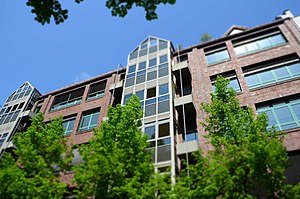Friedensburg High School
| Friedensburg High School | |
|---|---|

|
|
| type of school | Integrated secondary school |
| founding | 1975 |
| address |
Goethestrasse 8 - 9 |
| place | Berlin-Charlottenburg |
| country | Berlin |
| Country | Germany |
| Coordinates | 52 ° 30 ′ 30 " N , 13 ° 19 ′ 15" E |
| student | 1100 |
| Teachers | 120 |
| management | Sven Zimmer Various |
| Website | www.fosbe.de |
The Friedensburg-Oberschule (FOS) in Berlin is an integrated secondary school (formerly Integrated Comprehensive School ) with an upper level and the location of the “State European School Berlin” (SESB) for the German-Spanish language combination. With approx. 1,100 students and a weekly total of 2,400 teaching hours, it is one of the ten largest general education schools in Berlin.
history
The Friedensburg-Oberschule (FOS) was founded in 1975 as a comprehensive school for grades 7 to 10 with ten trains and up to 1200 students. The range of subjects, a differentiation of teaching according to performance, the integration of a great social and cultural diversity of the student body and the central position of work theory were the characteristics of the FOS in the first decade.
The regional school landscape in Charlottenburg is largely determined by high schools. In the first few years, for example, the question arose as to which students and parents at the school would guarantee the necessary variety of learning opportunities, talent and teaching staff in the long term. The establishment of an upper secondary school was approved in 1994. Four years later, the first year of upper school graduated from high school with 25 students, and today around 130 high school graduates take their exams every year. With the start of the 2016 school year, five classes were set up for the introductory phase for the first time. According to its own information, the FOS is one of the most popular schools in the district.
Due to the linguistic and cultural diversity, the school applied for a location for the “State European School Berlin” (SESB). This was achieved in 2003/04 with the German-Spanish profile. With the SESB student body, the school was enriched by new languages and nationalities as well as by new cultural influences; the language profile, in which Russian played an important role for decades, continued to develop. The SESB now comprises almost half of the student body, making it the largest SESB secondary school in Berlin. In grades 7 to 10, the school has four SESB and four regular classes per year. The linguistic and cultural influence of the SESB has significantly expanded the group of institutions that support the school as partners.
The school structural reform in 2010 brought about a profound change. Although only minor changes would have been necessary for the previous comprehensive school in the transition to the integrated secondary school, the school community decided to use the newly acquired design options. In a discussion and decision-making process, two essential pillars of the reform for the FOS were redesigned: The external performance differentiation according to the FEGA system , which was previously mandatory in Berlin , was replaced by a graduated system of internal differentiation with conclusion-oriented elements. The professional orientation was designed into a school-specific concept that is now attracting interest across the country.
In 2015 and 2020 the FOS was nominated for the German School Prize.
management
- 1975 to 1981: Burkhard Willimsky
- 1983 to 2003: Armin Grießmeyer
- 2005 to 2015: Paul Schuknecht
- 2015 to the present: Sven Zimmigart
Individual evidence
- ↑ Katrin Lange: The Charlottenburg School is one of the best in Germany . ( Morgenpost.de [accessed December 5, 2017]).
- ↑ School directory. Retrieved December 11, 2017 .
- ^ Editing Ganztagsschulen.org: All-day schools: Friedensburg-Oberschule Berlin: Europe as a value. Retrieved December 11, 2017 .
- ↑ The highest school price in sight. Retrieved December 11, 2017 .
- ↑ German School Prize: Berlin European School nominated for German School Prize . In: Berliner Zeitung . ( berliner-zeitung.de [accessed December 11, 2017]).
- ↑ Fifteen schools nominated for the German School Prize 2015 - Award ceremony by Chancellor Merkel on June 10 in Berlin . In: presseportal.de . ( presseportal.de [accessed December 11, 2017]).
